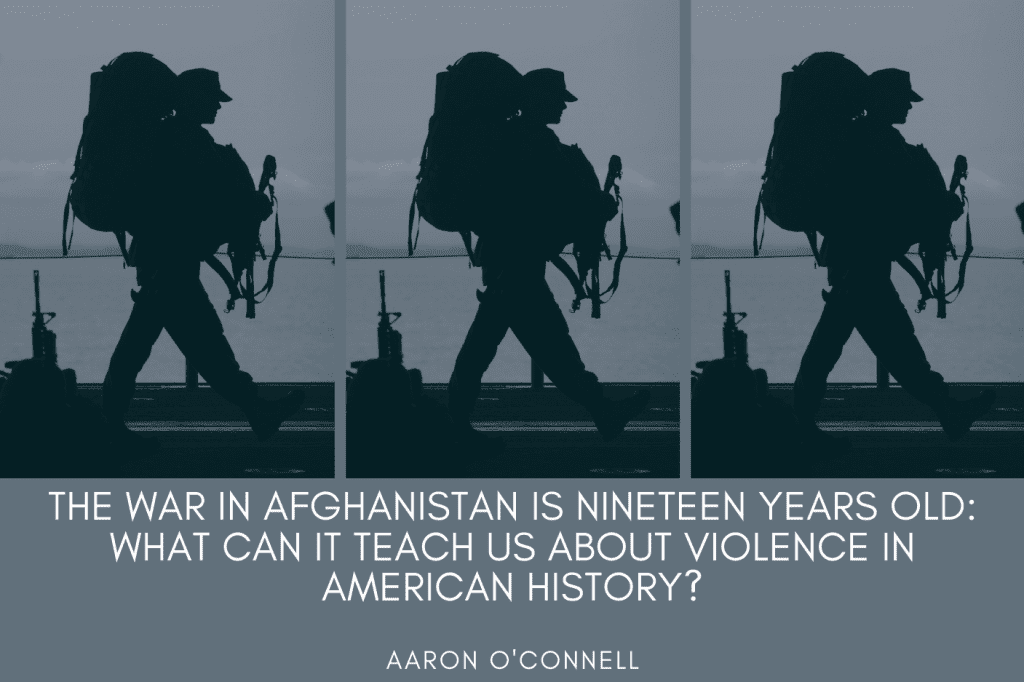
From the Editors: This article is accompanied by a comment from Jeremi Suri, the Mack Brown Distinguished Chair for Leadership in Global Affairs at the University of Texas at Austin. Such comments are a new feature for Not Even Past designed to provide different ways to engage with important new work.
This week marks the 19th anniversary of the start of the U.S. War in Afghanistan – an armed conflict that has been branded by some as the longest war in American history. But is that depressing label really accurate? If so, by what measures? If not, do terms like “endless” or “forever” wars have any explanatory value? What can they – or the Afghanistan war itself – teach us about patterns of violence in American history?
The first question – Is Afghanistan really the nation’s longest war? – seems like one of simple arithmetic. The war in Afghanistan began on October 7th, 2001 and continues to this day, making it roughly twice as long as the nation’s previous longest war, Vietnam. This, critics charge, is not only long but new: a state of constant, and seemingly endless “forever war,” that is a departure both from the principles of the founders and the isolationist tradition of the 19th and early 20th centuries.
As a military historian, I tend to wrinkle my brow when I hear claims like this, because none of those characterizations stand up well under scrutiny. In fact, there are several other candidates for America’s longest war besides Afghanistan—or Vietnam, for that matter. Most Americans just don’t know about them, or worse, want to ignore what they mean for America’s best stories about itself and its role in the world. In fact, state-sanctioned, organized armed conflict has been so regular the nation’s history that it is probably better to refer to Afghanistan as only our latest longest war – one of many in a pattern of armed conflicts that stretches back to before the nation’s founding.
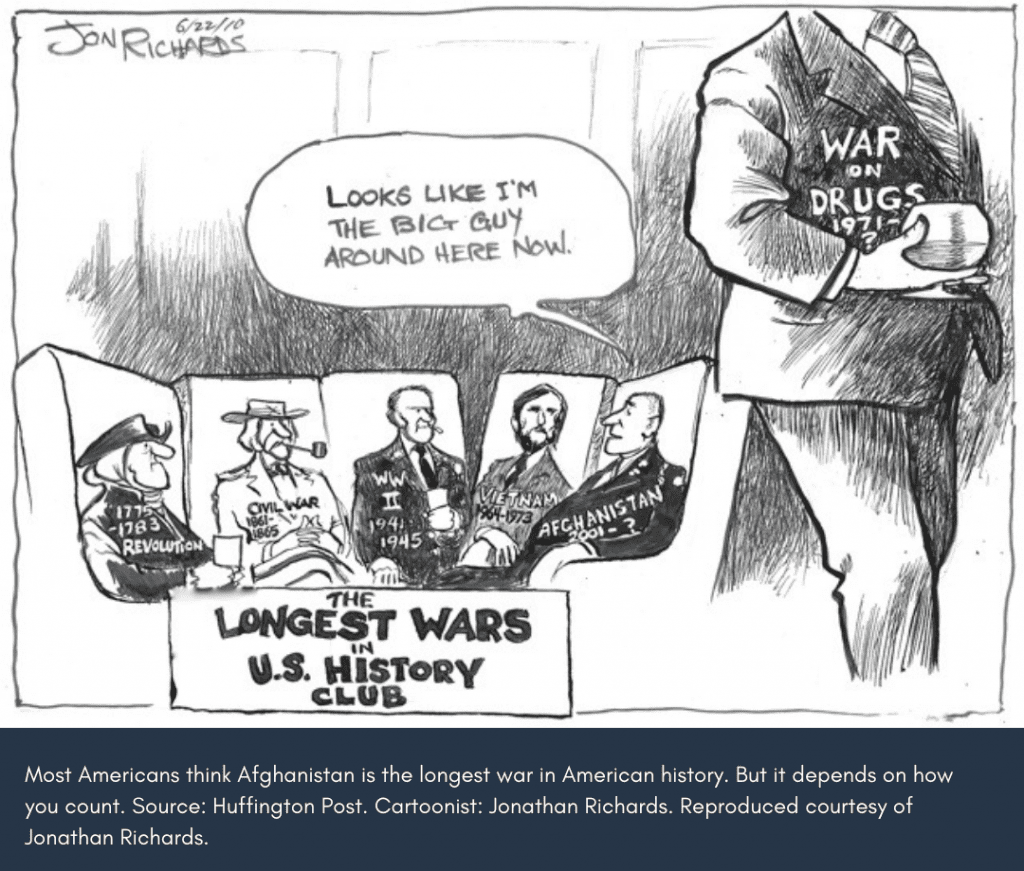
What’s in a Name?
So what is America’s longest war? Part of the problem is that it is difficult to know when a state of war actually exists. Should we only consider declared wars? Can words alone create a formal state of hostilities, or are lethal actions the real determinants? Must we send soldiers “equipped for combat” into foreign territory – the standard established by Congress’s 1973 War Powers Resolution? Does there need to be a single, named enemy? Depending on how one answers these questions, the list of wars and their durations grow and shrink.
Let’s first dispense with the notion that a war must be declared by Congress for it to exist. There is much to criticize the U.S. Government for in the Afghanistan War, but fighting it without a formal declaration is neither new nor even unusual in American history. Wars do not come into being simply because Congress uses the verb “declare.” If that were true, then the entire history of the United States would include just five formal wars and none after World War II.
Before the United States began its first declared war (the War of 1812), it had already fought three undeclared ones: the Northwest Indian War (1790-1795), the Quasi-War with France (1798-1800), and the First Barbary War, against the Bashaw of Tripoli (1801-1805). Nor was there a congressional declaration of war in the nation’s most deadly conflict: the Civil War (1861-1865). This was neither an oversight nor an accident: President Lincoln insisted Southern secession was not a war, but an illegal rebellion, in order to scuttle Southern efforts to gain diplomatic recognition from the United Kingdom.
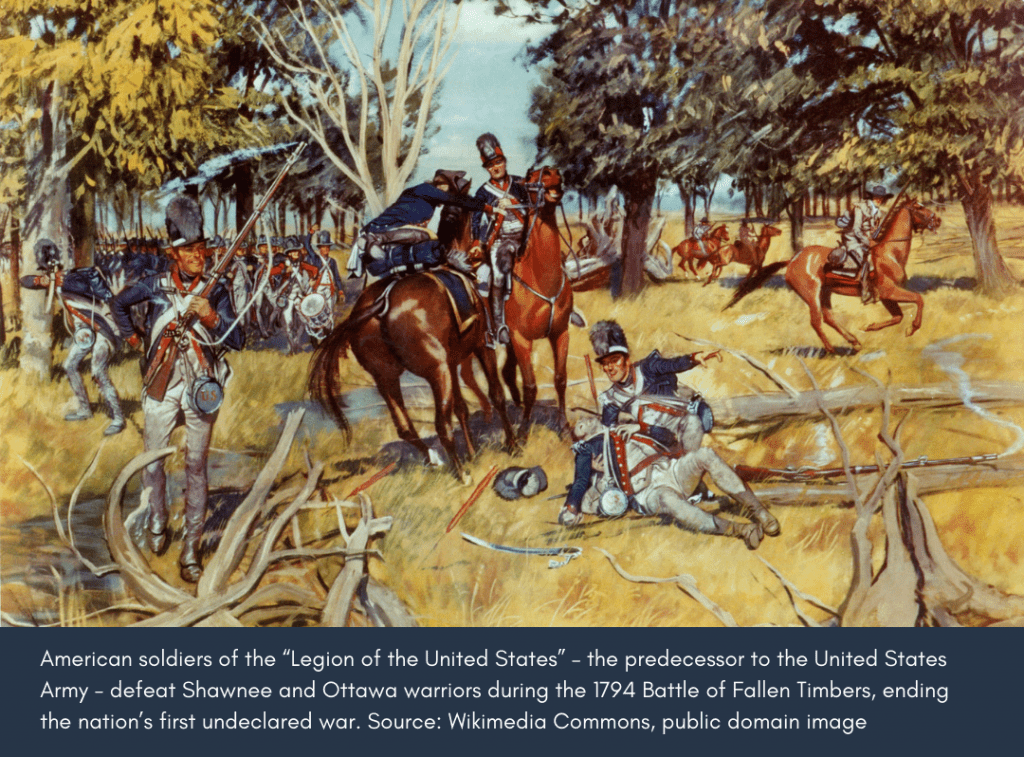
From these examples, it should be obvious that the words do not make the war. Rather, it is violence—and specifically, state-sanctioned, purposefully-directed violence against a group or linked groups—that moves a nation from a state of peace to a state of war. Using that standard, Afghanistan isn’t longest war in American history. In fact, it’s not even the longest war of most Americans’ lifetimes.
Afghanistan isn’t longest war in American history. In fact, it’s not even the longest war of most Americans’ lifetimes.
Searching for America’s Longest War
The Cold War ended just a decade before the Global War on Terror began, and that four-decade-long conflict involved regular, state-directed, lethal paramilitary operations – mostly covert – against Communist, Communist-linked, and Communist-leaning governments and insurgencies (as well as two “hot” wars in Vietnam and Korea). The War on Drugs, begun by President Nixon in 1971, has thus far lasted almost a decade longer than the Cold War and like Schrödinger’s Cat, seems to be both alive and dead today depending on which part of the U.S. government is doing the describing.
Some might dismiss these two conflicts as “metaphorical wars” or mere turns of phrase to mobilize public support. But that’s too simple. The essential elements of warfare are violent means to achieve political ends, whether undertaken by the U.S. military, covert American paramilitary forces, or foreign proxy forces fighting with American weapons and coordination. Those types of operations were regular in the Cold War and are still ongoing in the War on Drugs. According to a 2017 CATO Institute policy analysis, “American-backed, anti-drug operations in Mexico . . . have resulted in some of the bloodiest years in Mexican history. In fact, since former Mexican president Felipe Calderón began using the [American-supplied] military to fight cartels, more than 85,000 people have been killed.” Given that statistic, it seems hard to claim the War on Drugs isn’t a war or that the United States isn’t somehow part of it. But even if we exclude these two as somehow too indirect to count, Afghanistan still wouldn’t be the nation’s longest war.
The presence of combat-equipped military forces conducting violent operations abroad is a good common-sense test of when a state of war exists, and we’ve had those in Afghanistan for nineteen years. But the U.S. Navy and Marine Corps also occupied Haiti from 1915-1934 where armed Marines undertook a mix of police training, institution-building, and occasionally battled insurgents – precisely the tasks still being performed in Afghanistan. Fighting in Haiti was intense at times, involving pitched battles and the issuance of at least eight Congressional Medals of Honor. If one of these two occupations is a war, isn’t the other one as well?
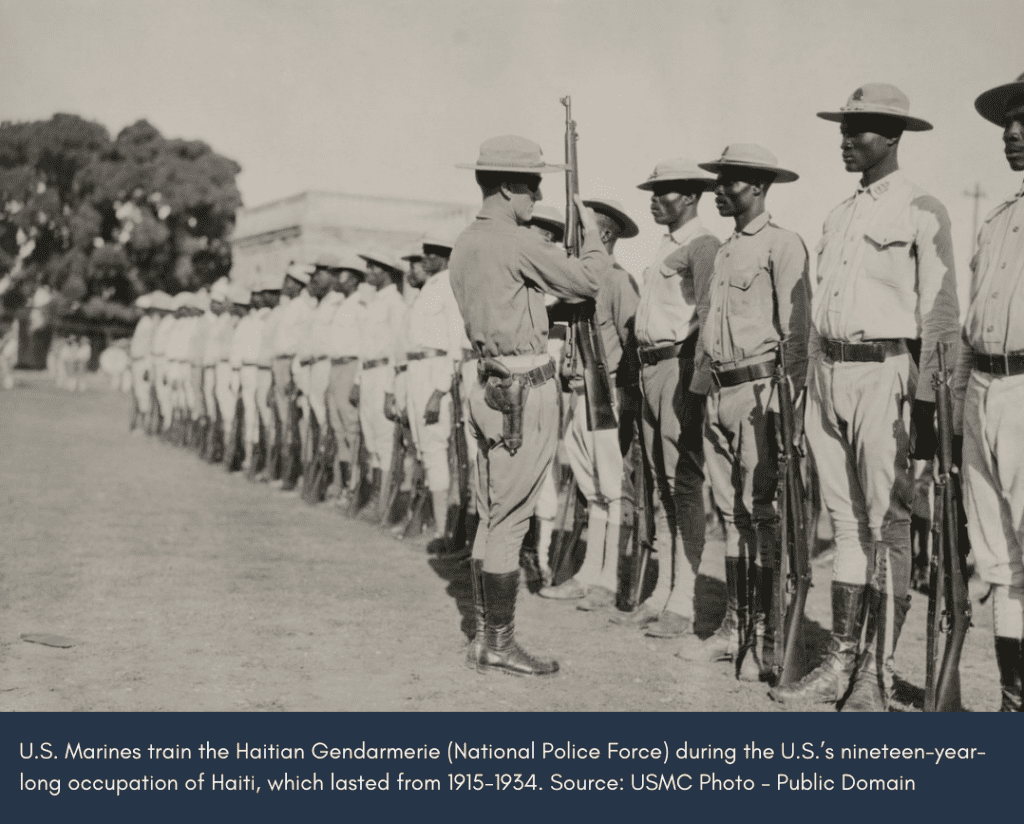
Significant numbers of U.S. forces also occupied and patrolled parts of China from 1912 to 1941 (29 years) to protect business interests and to respond to attacks on U.S. persons and facilities. It’s true that many of the “China Marines” at times enjoyed a relatively luxurious life in Shanghai and Peking, but the skirmishes and punitive landings were sufficiently numerous that by 1928, there were over 5,000 U.S. troops in China, equipped with mechanized vehicles, airplanes, and 44 separate naval vessels. In operations that the Congressional Research Service describes as occurring “continuously,” naval landing parties put down riots and battled “bandits,” while American gunboats and destroyers fired on Chinese boats and shelled the shores with four-inch deck guns.
But what about the relatively low intensity of these operations? Are these really wars or something short of them? One way to answer this question is to reverse the roles of the participants: If either China or Haiti had similar numbers of ships, planes, and troops stationed in the United States and firing on soldiers and civilians alike, would any American try to claim that the United States was somehow in a state of peace? My guess is no.
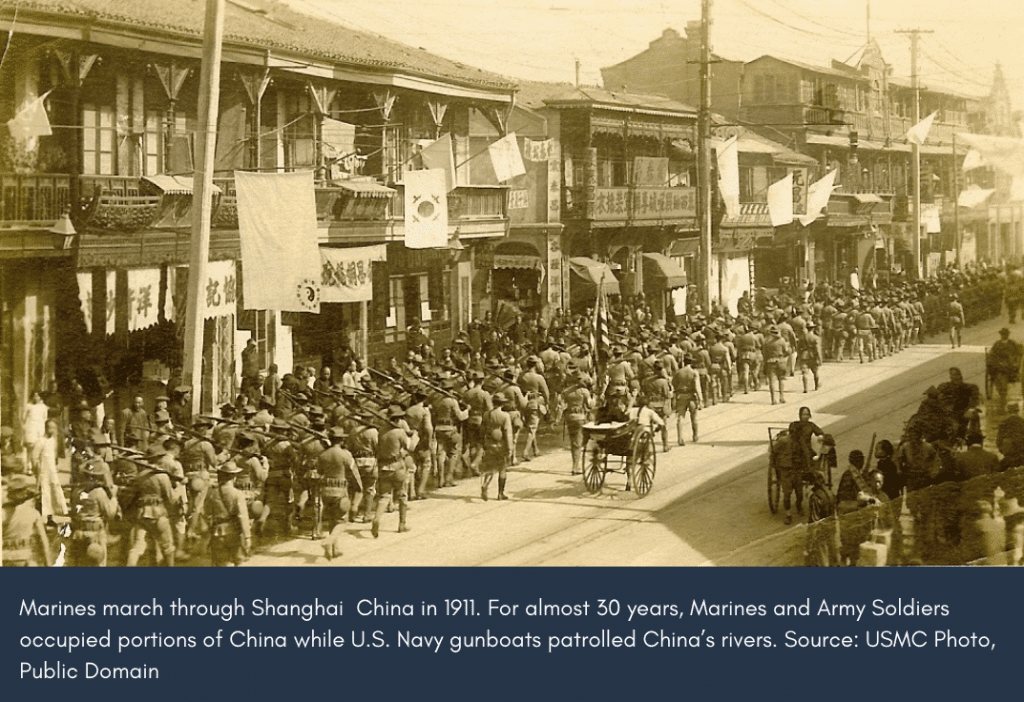
Nineteen years in Haiti. Twenty-nine years in China. Forty years of Cold War, including just how many in Vietnam? There’s no straightforward answer, because the U.S. began providing military support to the French fighting in Indochina as early as 1950. After French forces were defeated at Dien Bien Phu, the Pentagon created a Military Assistance and Advisory Group or “MAAG” for the new country of South Vietnam, and sent staff, planes, and pilots to Saigon, some of whom had to fly through small arms fire to land their aircraft. U.S. combat advisors followed in 1961 and by 1962, there were 11,000 of them in the country, undertaking tasks that were almost identical to today’s train, advise, and assist missions in Afghanistan.
These facts have created considerable confusion about the “official” start date for the Vietnam War. The Vietnam Veterans’ Memorial names the 1956 murder of Technical Sergeant Richard B. Fitzgibbon, Jr. as the first American death of the war, and both the Pentagon and the Department of Veterans’ Affairs speak of a “Vietnam War Era” with three potential start dates: 1955 (the creation of the new MAAG), 1961 (the first combat advisors), and 1964 (the Gulf of Tonkin incident). So, depending on how one counts, the American war in Vietnam lasted for either seven years, or fourteen years, or twenty years, making it both longer and shorter than the current war in Afghanistan and the Global War on Terror.
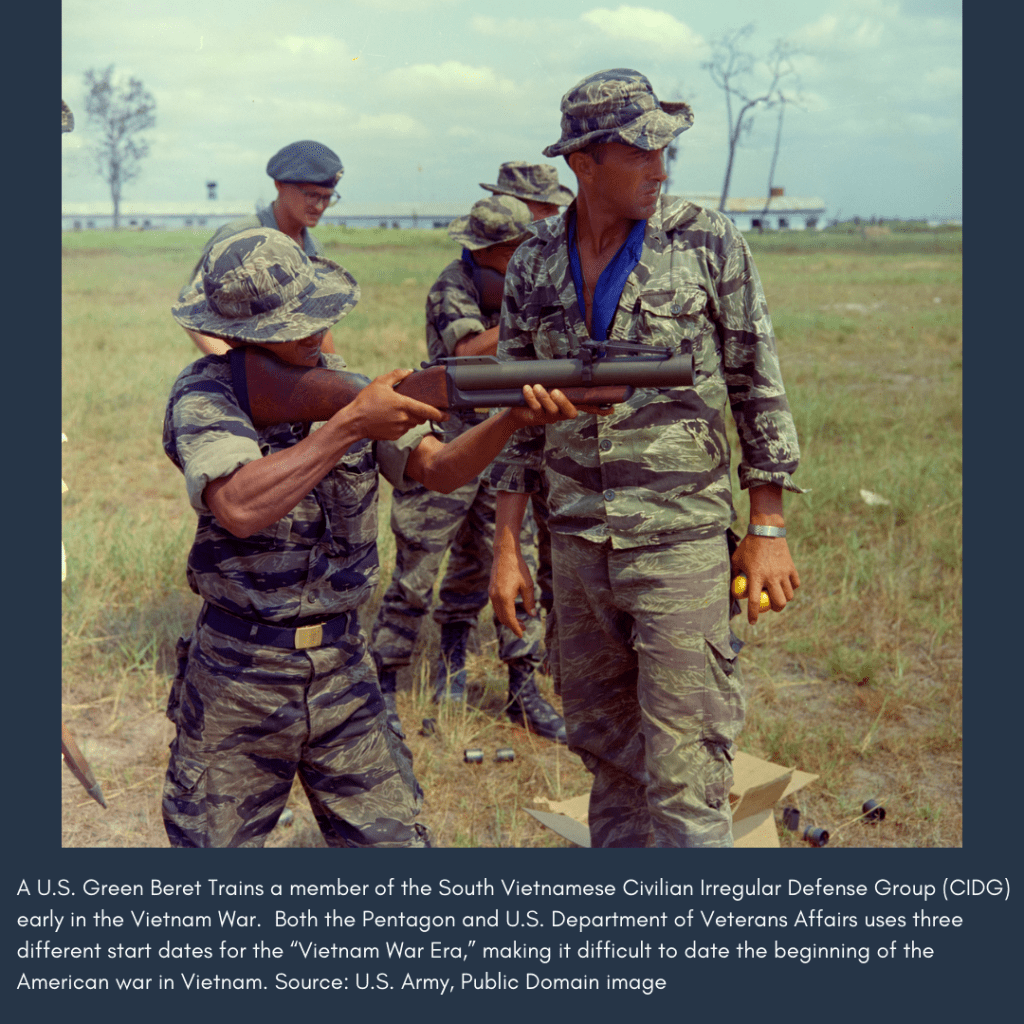
Eight Decades of Continuous Conflict?
If neither Afghanistan nor Vietnam is the nation’s longest war, then what is? Actually, the U.S. government has already weighed in on this subject, albeit indirectly. Every year, the Federal Register publishes the U.S. government’s officially-designated “periods of war” for calculating veterans’ benefits, and that list’s first entry spans more years than any other: “Indian Wars: January 1, 1817, through December 31, 1898, inclusive”: 81 years. (Of course, even this characterization understates the violence, because the military conquest of the continent didn’t begin in 1817; the U.S. had been in a state of constant conflict with various tribes since it became a nation and indeed, for more than a century before that.)
But can we even call these numerous conflicts a single war? Skeptics will charge that I am lumping when I should be splitting: the Indian wars are only a single continuous conflict if one overlooks the numerous cultural and linguistic differences between the tribes and disregards the occasional periods of low violence or temporary peace.
I disagree on both counts. There were, of course, real, long-standing cultural differences among the many Indian nations of North America, but none of those differences stopped the Anglos from organizing themselves militarily to remove Native Americans from the lands wanted for whites. Numerous military leaders and quite a few American presidents—the people actually ordering and performing the violence —considered all Native peoples as a single, inferior, race of savages, who, in Andrew Jackson’s famous words “must necessarily yield to the force of circumstances and ere long disappear.” This tendency to monolithize the enemy – which re-occurred in the Cold War in the War on Terror as well – not only meant constant, organized violence on the American frontier; it also produced several offensive operations against Indians who were at peace with the United States at the time, such as the Gnadenhutten Massacre (1782), the Sand Creek Massacre (1864) and Baker’s Massacre (1870), to name but a few. If the tribes’ many ethnic and cultural differences didn’t produce much differentiation on the battlefield, if neutral parties – and sometimes U.S. allies like the Lower Creeks – also found themselves subject to conquest and dispossession, then it makes sense to call the centuries-long “settling” (read: conquest) of the continent a single, racially-motivated war, and an act of ethnic cleansing to boot.
What about the occasional periods of temporary peace? Do those make it impossible to talk about a continuous war by whites to control the present-day United States? It’s hard to know, because federal troops, state and local militias, and armed vigilantes regularly attacked Native Americans even during the so-called periods of “peace.”
The constant military operations against native peoples means the “settling” of the continent was really a single, racially motivated war, and an act of ethnic cleansing to boot.
Take the conquest of Florida as an example. Military historians typically divide the wars against Florida’s native population into three: The First Seminole War (1816-18), Second Seminole War (1835-42), and a much smaller Third Seminole War (1855-58). But the lines between these three conflicts are muddy at best, and for the Seminoles, life was often no safer between the wars than in them.
Organized, state-sanctioned violence against the Seminoles began long before Andrew Jackson illegally invaded Florida in 1816; in fact, state militias had been conducting raids into Seminole territory at least since American independence, and both the Jefferson and Madison administrations authorized covert military operations in Florida to wrest it from Spain. The constant threat of violence worked. In 1819, Spain sold Florida to the United States, and raids and patrols were regular enough thereafter that today’s Seminoles still speak of a single “Seminole War,” not three separate conflicts. The State of Florida’s own Seminole Wars website admits something similar when it notes that “official and unofficial U.S. military expeditions” continued between the first and second Seminole Wars (and this says nothing about raids by state and local militias, who were often even less constrained in their actions than federal forces). Given these facts, it is fair to describe U.S. actions against the Seminoles as a war that lasted from at least 1816 to 1842 – six years longer than the current War in Afghanistan.
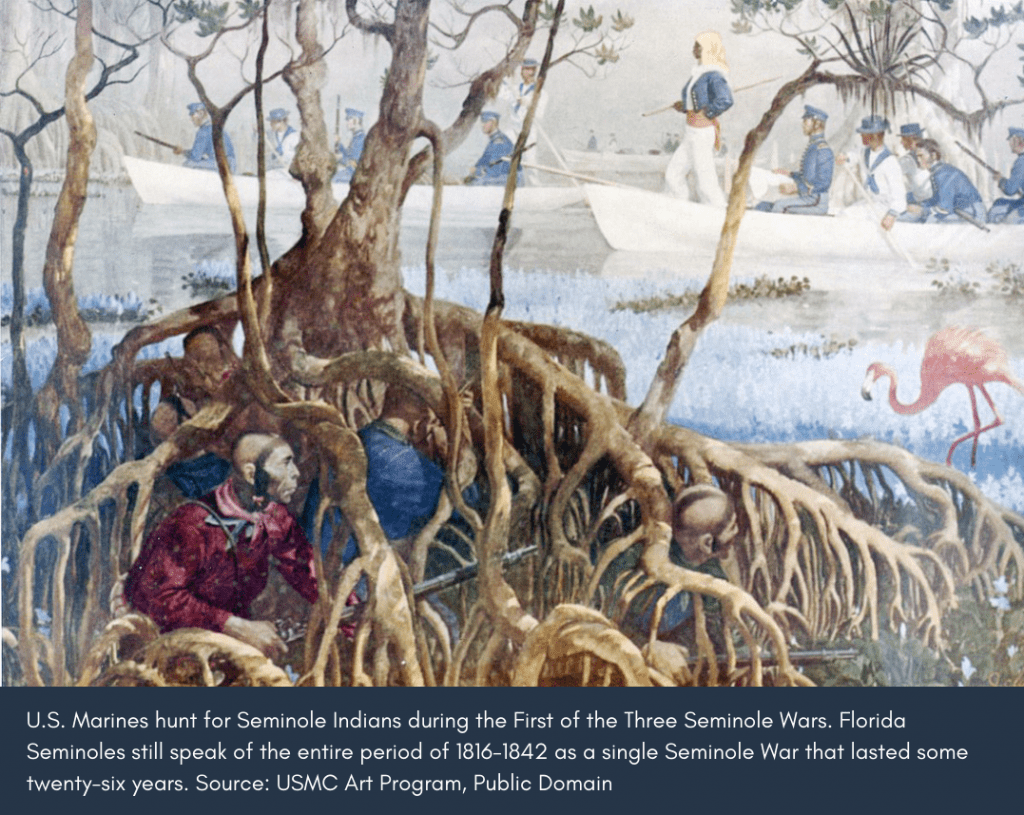
A Pattern of Endless Wars?
Given these facts, I think it fair to say that neither the War in Afghanistan nor the broader Global War on Terror are major aberrations in American history; rather, they are mostly continuations of a long-standing American preference for using military force to pursue political objectives, even ones that are perhaps better achieved using non-military tools. As historians like Richard Slotkin, Michael S. Sherry, and Andrew Bacevich have shown, war didn’t only create the United States, it has been an essential glue for the nation that has bound Americans together in a shared sense of purpose and community since the 18th century.
This process of building an imagined community through violence has made it fairly easy for presidents to gain public support for military operations outside the United States and to frame non-military problems in martial terms at home. It’s no wonder then that even as the United States is directly involved in very real wars in the Middle East, the Horn of Africa, and Central Asia, President Donald Trump is now using the language of warfare to describe federal actions against both peaceful protesters and the Coronavirus, just as President Nixon did with drugs, President Johnson did with poverty, and President Franklin D. Roosevelt did with the Great Depression. Warfare isn’t just the preferred tool for foreign policy anymore; it has become the preferred metaphor for federal problem solving.
What can thoughtful Americans take away from this depressing overview of little-known and hard to categorize conflicts? What can any of us do? The first step is for those who study history to raise our voices about just how common armed conflict has been in this nation’s history, particularly against non-white nations and groups.
Most Americans probably don’t consider themselves as particularly warlike, but it’s long past time to recognize that the United States is, both in culture and in action. In addition to the size of the U.S. defense budget and the monetary value of its arms sales (both the largest in the world), the United States is now using military violence in at least 14 separate countries, and has bases in 38 countries around the world. Another 120 or so countries receive U.S. military training or assistance – almost two-thirds of all nations in the world. To manage all of these ongoing military operations (not to mention the near-constant military exercises the U.S. conducts alone or with partners), Pentagon planners have divided the world up into six separate “combatant commands,” ensuring that every square inch of land and water on the earth is under the watchful eye of an admiral or general. For this and other reasons, in 2019, the Institute for Economics and Peace’s Global Peace Index ranked the United States as the third most militarized country in the world.
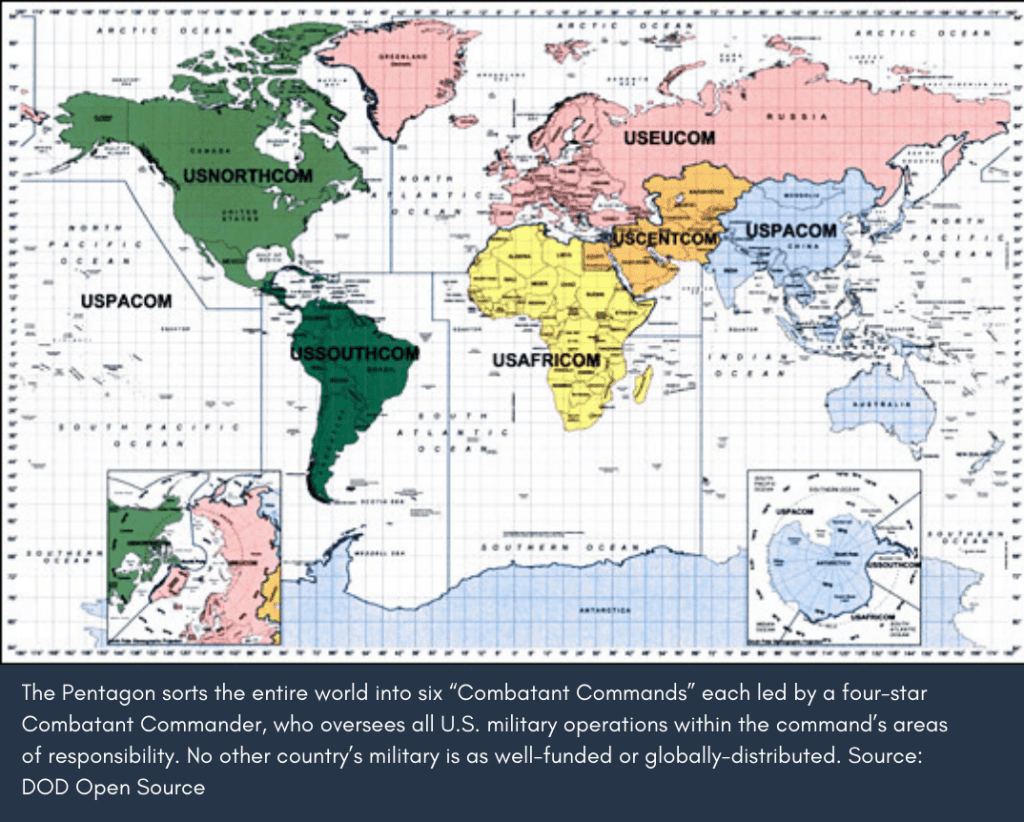
This isn’t to say that all or even most contemporary American military operations are either ill-intentioned or part of an earlier pattern of dispossession and conquest. But the history recounted above should at least force us to reject feel-good narratives that portray the United States as either fundamentally peace-loving or loath to use military force — two claims that are indefensible when compared against the historical record.
There are reasons why historian William Appleman Williams wrote of American “empire as a way of life” in 1980 – long before the current War on Terror – because even then, using violence to advance American interests abroad had become ordinary enough to hide in plain sight. But the facts of that history haven’t hidden themselves. They have been pushed into hiding by advocates of American exceptionalism who downplay or dismiss the irrefutable truths of America’s violent past, usually for political purposes. And when that happens, it’s the historian’s job to push back.
Need a final piece of evidence of just how constant organized violence has been in American history? Look no further than the Congressional Research Service’s annual report on the subject, which shows that the U.S. has sent troops into combat abroad in 208 of the previous 222 years – a staggering 94 percent of the total years covered. That may be a pattern of “endless” or “forever wars,” but it didn’t start with Afghanistan, and it probably won’t end any time soon.
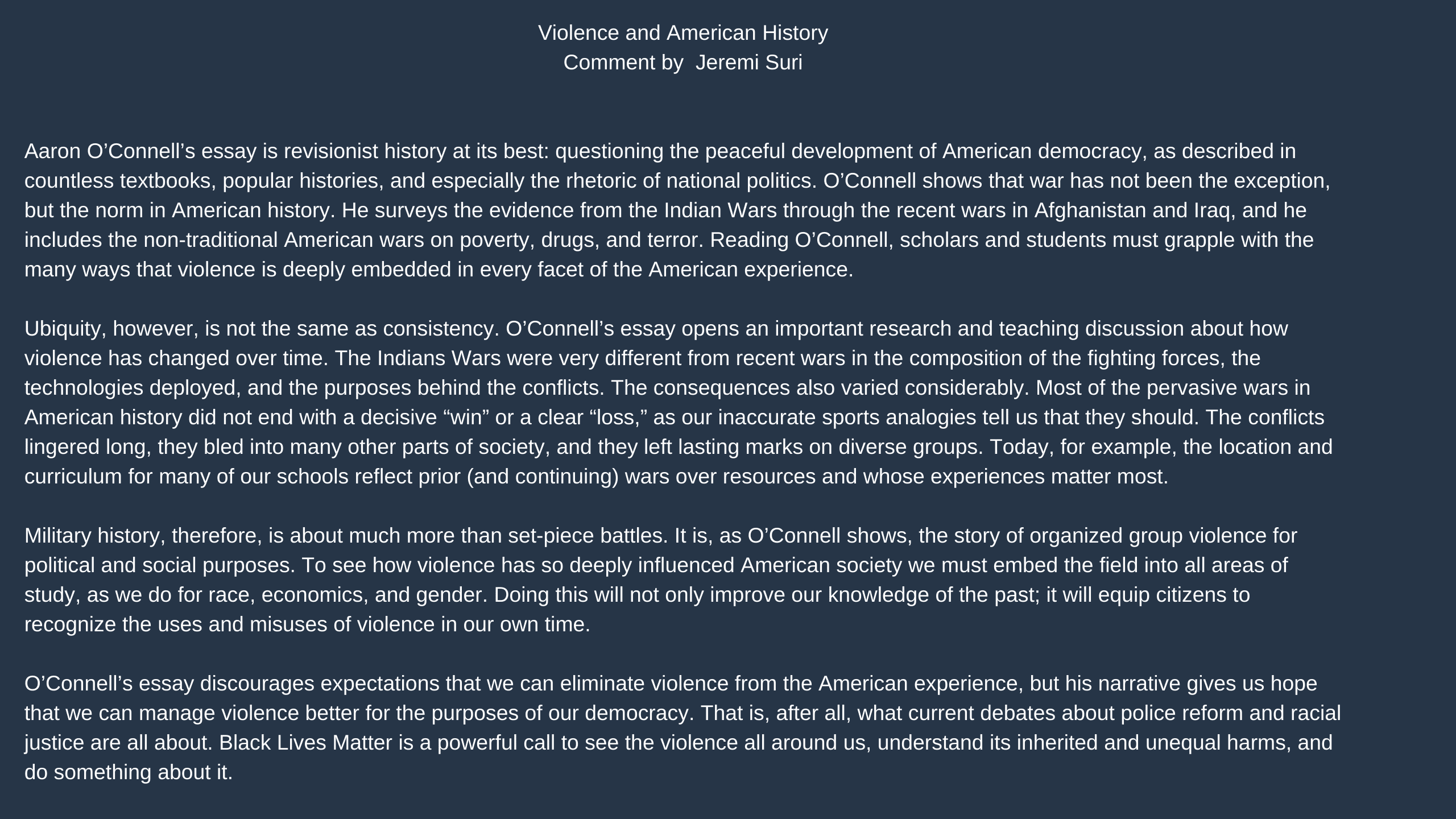
Aaron O’Connell is Associate Professor of American history at the University of Texas at Austin. Follow him on Twitter @OConnellAaronB. An earlier version of this article was presented at the Miller Center’s conference on “The Presidency and Endless War” at the University of Virginia.
Jeremi Suri holds the Mack Brown Distinguished Chair for Leadership in Global Affairs at the University of Texas at Austin. He is a professor in the University’s Department of History and the Lyndon B. Johnson School of Public Affairs. Dr Suri is also the host of a weekly podcast, “This Is Democracy“ which can be listened to here or on the Not Even Past homepage.



